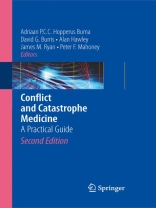Six years have passed since the first edition of Conflict and Catastrophe Medicine was published. Those 6 years have not been peaceful: conflict has continued in Iraq, Afghanistan, Africa, and the Middle East. Terrorist attacks have continued around the world and London has had its first experience of suicide bombings. The landscape for humanitarian work is dangerous and challenging. The aim of this second edition is in line with the first edition – to provide an ent- level resource for people working (or considering work) in a hostile environment. Contributors with real hard one practical experience have been invited to share their views, and they do this with a raw honesty in a variety of writing styles. The second edition of Conflict and Catastrophe Medicine has benefited from these contributions, and we hope our prospective readers will do so as well. The book editors are donating their royalties from this book to the charity “Help for Heroes’. Adriaan Hopperus Buma Alan Hawley David G. Burris James M. Ryan Peter F. Mahoney v Preface to the First Edition This work is intended as an entry-level text aimed at medical, nursing and pa- medical staff undertaking work in a hostile environment.
Inhaltsverzeichnis
Introduction: Players and Paradigms.- Baghdad Christmas.- New Paradigms: The Changed World Since 9/11.- The World Seems to be Crumbling Around Us.- The Spectrum of Conflict.- The Players: Humanitarians, Militaries, Industry and Private Security Companies.- Interfaces.- Conflict and the Media.- Remote Medicine.- Disasters, Public Health, and Populations.- Disasters: An Overview.- Responding to Acute Humanitarian Crises: Health Needs Assessment and Priorities for Intervention.- The Military Approach to Medical Planning.- Health Risk Management Matrix: A Medical Planning Tool.- Surveillance and Control of Communicable Disease in Conflicts and Disasters.- Health Planning in Action: Rwanda Crisis.- Health Planning in Action “Operation Phoenix”: A British Medical Aid Program to Sarajevo.- Health Care of Prisoners and Detainees.- Populations and People.- Introduction: Living and Working.- Getting There and Being Involved.- Safety and Security.- Voices from the Field.- Applied Communications in Conflict and Catastrophe Medicine.- Mental Health.- Introduction: Hospitals and Health Systems.- Conflict Recovery-Health Systems in Transition.- Eating an Elephant: Intervening in Hospitals, Pristina.- Conflict Surgery: A Personal View.- Military Health Services Support in Conflict.- Military Medical Assistance to Security Sector Reform.- Hospital Blues.- Introduction: Clinical Care.- Trauma and Surgery.- Acute Medical Problems.- Women’s Health.- Children’s Health.- Conflict, Terrorism, and Disasters: The Psychosocial Consequences for Children.- Introduction: Resources.- Materials and Information.- Rehabilitating Diagnostic Laboratories.- Enablers and Confounders: Achieving the Mission.- Ministry Overlaps Within Health Sectors.- Accreditation in Field Medicine.- Humanitarian Work in the Era of Modernising Medical Careers.












